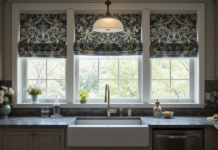Last Updated on July 14, 2024 by Asfa Rasheed
Redesigning a home can be an exciting yet daunting task. Whether you’re renovating to enhance functionality, improve aesthetics, or increase property value, there are several key considerations to keep in mind throughout the process. From selecting the right kitchen layouts to ensuring cohesive design elements, each decision plays a vital role in achieving your desired outcome. Let’s delve into the essential factors to consider when embarking on a home redesign journey.
Table of Contents
Understanding Your Needs and Goals
Before diving into the specifics of redesigning your home, it’s crucial to understand your needs and goals. Take the time to evaluate what aspects of your current space are working well and what areas could use improvement. Consider your lifestyle, family size, and any future plans that may impact the design. Are you looking to create a more open-concept layout for entertaining guests? Or perhaps you need to optimize storage solutions to declutter your living space? By clearly defining your objectives, you can prioritize enhancements that align with your vision.
Choosing the Right Kitchen Layouts
The kitchen is often considered the heart of the home, making its layout a critical aspect of any redesign project. When selecting a kitchen layout, several factors come into play, including available space, workflow efficiency, and personal preferences. Common kitchen layouts include galley, L-shaped, U-shaped, and island configurations, each offering unique advantages depending on your needs.
For smaller spaces, a galley kitchen layout maximizes efficiency by placing appliances and cabinets along two parallel walls, creating a compact yet functional workspace. Alternatively, an L-shaped or U-shaped layout provides ample counter space and storage while allowing for better traffic flow in larger kitchens. Introducing a central island can add versatility, serving as a prep area, dining space, or additional storage depending on your requirements.
Optimizing Space and Functionality
Efficient use of space is key when redesigning a home, especially in areas where square footage is limited. Look for opportunities to optimize functionality without sacrificing aesthetics. Built-in storage solutions, such as custom cabinets and shelving units, can help maximize storage capacity while maintaining a streamlined appearance.
Consider multifunctional furniture pieces that serve dual purposes, such as a sofa bed or extendable dining table, to adapt to changing needs. Additionally, explore innovative space-saving techniques, such as hidden storage compartments and fold-down desks, to make the most of every square inch.
Creating Cohesive Design Elements
A cohesive design scheme ties the various elements of your home together, creating a harmonious aesthetic that flows seamlessly from room to room. Start by establishing a cohesive color palette that complements your overall theme and reflects your personal style. Whether you prefer a monochromatic scheme for a modern look or a mix of bold hues for a vibrant feel, consistency is key in creating visual unity.
Incorporate cohesive design elements, such as consistent flooring materials, trim, and hardware finishes, to create a sense of continuity throughout your home. Pay attention to transitions between spaces, ensuring a smooth flow between rooms by maintaining consistent design elements and architectural details.
Balancing Form and Function
Finding the balance between form and function is essential when redesigning a home. While aesthetics play a significant role in creating a visually appealing space, functionality should never be overlooked. Prioritize practical considerations, such as ergonomic furniture arrangements, adequate lighting, and efficient storage solutions, to enhance usability and comfort.
Invest in high-quality materials and finishes that not only elevate the aesthetic appeal of your home but also withstand the rigors of daily use. Whether you’re selecting flooring, countertops, or fixtures, opt for durable options that require minimal maintenance and offer long-term durability.
Incorporating Personalized Touches
Infuse your personality into your home redesign by incorporating personalized touches that reflect your individual taste and preferences. Whether it’s displaying cherished artwork, incorporating heirloom furniture pieces, or integrating meaningful mementos, these personal touches add character and warmth to your living space.
Consider incorporating elements of biophilic design, such as indoor plants and natural materials, to create a connection with nature and promote a sense of well-being indoors. Embrace your creativity by experimenting with textures, patterns, and decorative accents to add visual interest and personality to your home.
Seeking Professional Guidance
While DIY projects can be rewarding, complex home redesigns may require professional expertise to ensure optimal results. Consider consulting with interior designers, architects, or contractors who can provide valuable insights and guidance throughout the redesign process.
Collaborating with professionals allows you to tap into their expertise and access resources that may not be readily available to the average homeowner. From space planning and layout optimization to material selection and project management, their input can help streamline the redesign process and achieve your desired outcome efficiently.
Embracing Sustainability in Home Redesign
As the world shifts towards sustainable living practices, integrating eco-friendly solutions into home redesign projects has become increasingly important. Sustainable design not only minimizes environmental impact but also promotes healthier living spaces and reduces long-term operating costs. When redesigning your home, consider incorporating sustainable materials, energy-efficient appliances, and environmentally conscious design strategies to create a more eco-friendly and resilient living environment.
Conclusion
Redesigning a home is a multifaceted endeavor that requires careful planning, creativity, and attention to detail. By understanding your needs and goals, selecting the right kitchen layouts, optimizing space and functionality, creating cohesive design elements, balancing form and function, incorporating personalized touches, and seeking professional guidance when needed, you can transform your living space into a functional and aesthetically pleasing environment that reflects your unique style and enhances your quality of life. Whether you’re embarking on a minor renovation or a full-scale remodel, these key considerations will serve as a roadmap to success in achieving your home redesign aspirations.



























